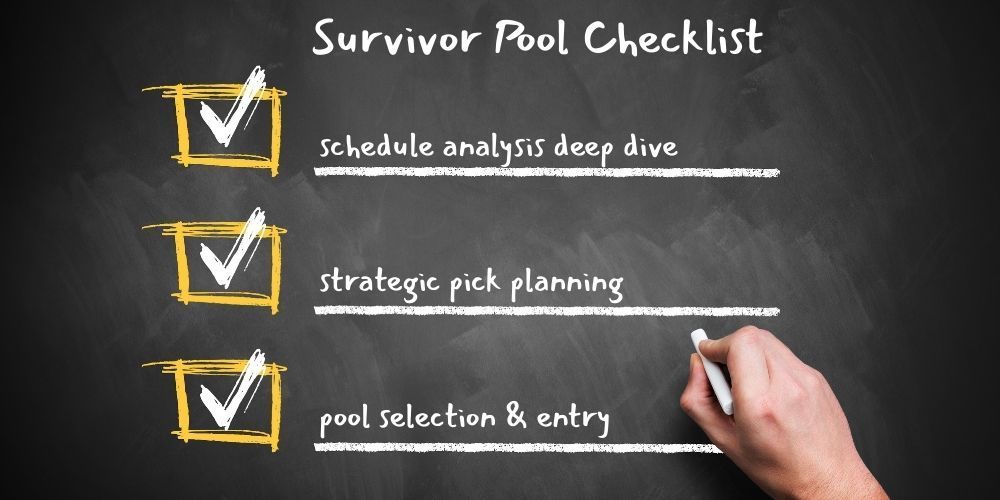The Math Behind Survivor Pools: Win Probability Explained
William Flaiz • May 12, 2025
Ever wonder why some people consistently last longer in survivor pools? It's not just luck—it's math. Understanding the probability behind your picks can be the difference between an early exit and claiming the prize money.
In this guide, we'll break down the mathematical concepts that power winning
survivor pool strategies, explain core probability principles, and show you how to apply them to make smarter picks throughout the NFL season.

The Foundation: Basic Win Probability
At its core, survivor pool success depends on correctly predicting who will win each week. But not all wins are equally likely.
Single-Week Probability Explained
Sportsbooks provide point spreads that can be converted to win probabilities. For example:
| Point Spread | Approximate Win Probability |
|---|---|
| -3 | 59% |
| -7 | 75% |
| -10 | 82% |
| -14 | 90% |
These probabilities aren't perfect (no prediction can be), but they represent market consensus and provide a solid foundation for decision-making.
Formula: To convert a spread to win probability:
Win Probability = 0.5 + (Point Spread × 0.03)
This simplified formula works well for most spreads between -3 and -14. For example, a team favored by 7 points has approximately a 0.5 + (7 × 0.03) = 0.71 or 71% chance of winning.
Cumulative Probability and Season-Long Strategy
The biggest mistake survivor pool players make is focusing only on the current week. Optimal strategy requires looking ahead.
Survival Probability
Your overall probability of surviving multiple weeks is the product of each individual week's win probability:
P(surviving weeks 1-n) = P(week 1) × P(week 2) × ... × P(week n)
Example: If you pick teams with 80% win probability each week:
- Week 1 survival chance: 80%
- After Week 2: 80% × 80% = 64%
- After Week 3: 80% × 80% × 80% = 51.2%
- After Week 4: 80% × 80% × 80% × 80% = 41.0%
This shows how quickly your chances deteriorate, even with seemingly "safe" picks. This math explains why most participants in large pools are eliminated by midseason!
Expected Value: The Key to Optimal Picks
Smart survivor pool players don't just pick the team most likely to win each week. They consider:
- Win probability
- Pick popularity
- Future value of each team
The Expected Value Formula
EV(Team X in Week Y) = P(Team X wins) × P(You win pool | Team X wins)
When comparing options, the team with the highest expected value is your optimal pick, not necessarily the team most likely to win that week.
Factoring in Pick Popularity
When many contestants pick the same team, your expected value decreases because you'll need to share the prize pool if that team wins.
Advanced Formula:
EV = P(Team Wins) × [Pot Size ÷ (Your Entry Count × % of Entries Picking Team)]
This explains why contrarian picks can be mathematically justified, especially in large pools where uniqueness has value.
Future Value and Opportunity Cost
Each team can only be used once in standard survivor pools. Using a strong team in Week 1 means you can't use them in Week 10 when they might be an even stronger pick.
Calculating Future Value
The future value (FV) of a team is the advantage you gain by saving them for a future week:
FV = Max[P(win week X) - P(next best option week X)]
The larger this value, the more incentive you have to save a team.
Example: The Chiefs might have a 90% win probability in Week 1, but if your next best option is 85%, the opportunity cost of using them is small (5%). However, in Week 8 when they face a weak opponent and your next best option is only 65%, their future value is much higher (25%).
Optimal Pick Selection Process
Putting it all together, the mathematical approach to pick selection follows these steps:
- Calculate win probabilities for all teams each week
- Estimate pick popularity for top options
- Project future value for each team
- Calculate expected value of each option
- Select the option with highest expected value
This process balances immediate survival with long-term optimization.
Real-World Application: 2024 Season Example
Let's look at Week 2 of the 2024 season as an example:
| Team | Opponent | Spread | Win Prob | Pick % | EV |
|---|---|---|---|---|---|
| Ravens | at Cardinals | -9.5 | 81% | 30% | 2.7 |
| Cowboys | vs. Giants | -8.5 | 78% | 15% | 5.2 |
| Chiefs | at Falcons | -7 | 72% | 11% | 6.5 |
| Bills | vs. Raiders | -7 | 72% | 17% | 4.2 |
Despite the Ravens having the highest win probability, the Chiefs had the highest expected value due to lower popularity and moderate future value. This illustrates why blindly picking the biggest favorite isn't always optimal.
Using Software and Calculators
While understanding the math is valuable,specialized tools can help with the complex calculations needed to optimize picks throughout a full season.
Survivor pool calculators factor in:
- Current and future win probabilities
- Pool-specific rules
- Contestant behavior patterns
- Remaining teams in your pool
These tools run thousands of simulations to identify the pick that maximizes your chance of winning the pool, not just surviving the current week.
Practical Takeaways
Even without complex calculations, you can apply these mathematical principles to improve your survivor strategy:
- Always consider future value - Don't burn top teams early unless necessary
- Factor in pick popularity - Being contrarian in large pools often has positive expected value
- Think in probabilities, not certainties - Even 90% favorites lose 1 in 10 times
- Plan multiple weeks ahead - Map out potential paths for at least 3-4 weeks
- Adjust as the season progresses - Injury news and performance trends significantly impact probabilities
Conclusion
The math behind survivor pools isn't just academic—it's the foundation of a winning strategy. By understanding basic probability, cumulative effects, expected value, and opportunity cost, you can make more informed decisions and gain an edge over competitors who rely on gut feeling alone.
Smart survivor pool players don't just pick winners—they maximize expected value while balancing immediate survival with long-term optimization. It's this mathematical approach that separates consistent winners from the crowd.
Learn more about how pool size impacts strategy,
How Pool Size Affects Your Survivor Strategy: From Small Leagues to Massive Pools.
What's more important in survivor pools: win probability or pick popularity?
Both factors are crucial components of expected value. In smaller pools (under 50 people), win probability typically carries more weight because the chances of duplicate winning entries are lower. In larger pools (100+ entries), pick popularity becomes increasingly important as the value of differentiation grows. The optimal mathematical approach weighs both factors based on pool size, remaining contestants, and prize structure. For example, in a 1,000-person pool where 40% are picking the heaviest favorite, choosing a team with an 80% win probability that only 5% of entrants are selecting often yields higher expected value than the 90% favorite.
How do I calculate the risk of saving a team versus using them now?
This involves comparing opportunity costs across different weeks. Calculate the difference between your top option and next-best option for the current week. Then project when you might use that team in the future and estimate the difference between that team and your likely alternative for that future week. If the current week's gap is smaller than the projected future gap, it's mathematically sound to save the team. For example, if using the Bills now gives you a 5% edge over your next option, but using them in Week 10 might provide a 15% advantage over alternatives that week, the math suggests saving them (assuming you have another viable option now).
Does the math change in survivor pools that allow you to pick against teams rather than for winners?
Yes, the fundamental mathematics remains the same, but the specific calculations flip. Instead of identifying teams most likely to win, you're identifying teams most likely to lose. The same principles of expected value, future value assessment, and contrarian strategy still apply. However, the distribution of probabilities tends to be different—there are often more teams with very high probabilities of losing (90%+) than teams with very high probabilities of winning. This changes the risk/reward calculations and often makes contrarian picks less valuable since the base probabilities for top options are higher. Always adapt your mathematical approach to the specific rules of your pool.











